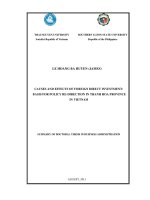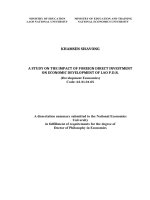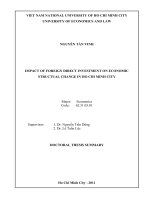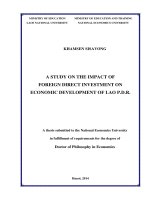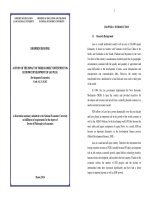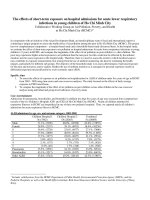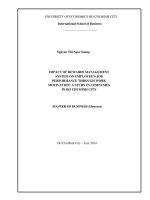IMPACT OF FOREIGN DIRECT INVESTMENT ON ECONOMIC STRUCTUAL CHANGE IN HO CHI MINH CITY
Bạn đang xem bản rút gọn của tài liệu. Xem và tải ngay bản đầy đủ của tài liệu tại đây (176.99 KB, 20 trang )
VIET NAM NATIONAL UNIVERSITY OF HO CHI MINH CITY
UNIVERSITY OF ECONOMICS AND LAW
NGUYỄN TẤN VINH
IMPACT OF FOREIGN DIRECT INVESTMENT ON ECONOMIC
STRUCTUAL CHANGE IN HO CHI MINH CITY
Major:
Code:
Supervisor:
Economics
62.31.03.01
1. Dr. Nguyễn Tiến Dũng
2. Dr. Lê Tuấn Lộc
DOCTORAL THESIS SUMMARY
Ho Chi Minh City - 2011
1
INTRODUCTION
1. Problem statement
Industrialization and modernization of the economy and proactive
international economic integration are the pressing issues for countries at low
level of economic development. Raising the level and extent of the resources
and building up a modern and sustained economic structure are of the core
contents. Structural transformation becomes an objective factor of the
development of national economy in the globalization era. FDI has an
important role and through FDI, the host country has an opportunity to
participate in the international division of labor, thereby raising the level of
development, creating a driving force for structural transformation. Vietnam
has always paid a great attention to attracting FDI to supplement the
investment capital for development, promoting economic structural change.
FDI has spillover effects to the economic sectors, and contribute to
modernization of the economy, but FDI does not always have a positive
impact. Therefore, if not analyzing of weaknesses in attracting and using FDI,
we cannot draw possible solutions to promote positive and minimize negative
impacts from to transfer funds ECONOMIC STUCTURAL.
Ho Chi Minh City, a major economic center of the region and the
country, has a dominant role over the capability of the country’s economic
growth. The city is the one that leads the attraction of FDI, has the advantage
in building a modern economic structure and gradually implement
development in depth. Analyzing whether FDI actually affects the economic
structural change or not? If so, to what extent? And how to promote the
positive aspects and minimize the negative impact of FDI on the structural
change in Ho Chi Minh City are issues that researchers are still not so clear.
Therefore, the issue "Impact of Foreign Direct Investment on the economic
structural change in Ho Chi Minh City" has been chosen to write a PhD
thesis.
2
2. Overview of empirical studies
Works related to foreign direct investment and structural change
concentrate on the following issues:
2.1. Analysis of current situation of attracting FDI at the provinces and
delivery of main solutions. Some studies to named, such as: "Improving the
investment environment to attract FDI in some Asian countries and lessons
for Vietnam" by Duong Thi Binh Minh, Nguyen Thanh Thuy (2009), on
Review of Economic Development, (225), p.15-22, “Foreign Investment in
Vietnam period 1991-2000” by Nguyen Ngọc Thanh & Nguyen Dinh Mai
(Finance Publishing House, Hanoi, 2001).
2.2. Rationale on the nature, the content and the role of FDI for Vietnam's
economy. A list of works including: “The impact of foreign direct investment
on economic growth in Vietnam” by Le Xuan Ba (Scientific Publishing
House, Hanoi, 2006), "The role of foreign direct investment for development
and economic growth in Vietnam" by Nguyen Thi Canh (2009), Review of
Economic Development, (225), p. 2-7. Authors estimate the impact of FDI on
economic growth, but not the impact of FDI on economic structural change.
2.3. Solutions to improve the system of laws and policies related to
foreign investment activities in Vietnam. Some studies are: "Foreign Direct
Investment in Vietnam - The shortcomings of policy and solutions" of Do
Duc Binh (2009), Journal of Economics and Development, (145), p. 6-9,
"Transparency of the legal system and policies on foreign investment: Current
situation and solutions" by Tran Hoa Hung (2005), Journal of Economics and
Forecasting (3), p. 6-8.
2.4. Summary
of the achievements of foreign direct investment in
Vietnam. Some works are: "Foreign Direct Investment in Vietnam:
Achievements and development solutions" of Ho Van Vinh (2003), in Journal
Political Theory, (4), p. 39, "Foreign Direct Investment in Vietnam: 17 years
3
looking back" by Bui Hoai Nam (2005), Journal of Press and Propaganda, (2),
p. 24-27. The article reviews the results of Vietnam's FDI attraction,
indicating the limitations, from which proposing solutions to attract FDI.
2.5. Foreign Direct Investment and the process of industrialization and
modernization in Vietnam, analysis of the experiences of other countries.
Some works include: “Foreign direct investment for industrialization in
Malaysia and experience for Vietnam” (World Publishing, HN, 2000) of
Phung Xuan Nha, “Foreign direct investment with the industrialization and
modernization in Vietnam” by Nguyen Trong Xuan (Social Sciences
Publishing House, Hanoi 2002).
2.6. The studies on FDI, and the structural change in Ho Chi Minh city.
To name some such as: “Final Report on orientation to attract partners for
foreign direct investment in structural transformation in Ho Chi Minh city” by
Nguyen Van Quang (Project leader, 2007), “On the structural transformation
of economic sectors in Ho Chi Minh city in the process of industrialization
and modernization” (Social Sciences Publishing House, Hanoi, 2000) by
Truong Thi Minh Sam. Overall, the scientific work above mentioned point
out problems related to FDI, but they do not study the comprehensive and
quantitative impact of FDI on structural transformation.
3. Objectives and tasks of the dissertation
Thesis aims at unveiling theoretical and practical basis of the impact of
FDI on the structural transformation through sectoral economic growth in Ho
Chi Minh City, and thereafter proposes fundamental solution to attract and
use FDI to promote an efficient and sustainable transformation of economic
structure in Ho Chi Minh city. To achieve this purpose, the thesis has the
following tasks: (1) Overview of issues related to FDI and structural change,
including a clarification of concepts, theories on the impact of FDI over
sectoral transformation of economic structure, (2) Analysis of current
situation in attracting and using FDI and its impact over structural change in
4
Ho Chi Minh city. (3) Determination of the objectives, direction and proposed
solutions in terms of mechanisms and policies to attract and use FDI so as to
speed up structural change in Ho Chi Minh city efficiently and sustainably.
4. Object, scope and methodology
4.1. Study objects
Study objects of the thesis is to analyze the impacts of FDI on the
sectoral structural change in Ho Chi Minh city, to present objectives,
directions and solutions on the mechanism and policies so as to attract and use
of FDI to promotion structural change.
4.2. Scope of research
The thesis focuses on the impact of FDI on sectoral structural change
(including: agriculture, industry and services) and the internal structure of
industrial sector in Ho Chi Minh city. Data used to examine FDI, structural
change are taken from 1988 to 2009 and solutions are proposed till 2020.
4.3. Research Methodology
The thesis uses dialectic materialism of Marxism - Leninism in
combination with using a particular methodology consistent with the content
analysis of the thesis, including:
- The method of historical materialism of Marxism - Leninism to draw
perspectives, the rationale of attracting FDI, and the experience of economic
structural change.
- Methods of analysis and synthesis in order to find the quantitative
relationship between FDI and economic structural change.
- Methods of descriptive statistics to assess the role, and limitations of
FDI in the economic structural change and socio - economic development as
well. The method of multivariate regression analysis is used to examine the
impact of FDI on sectoral change of economic structure.
5
5. The contributions of the thesis
- Develop theoretical framework and propose a model to analyze the
impact of FDI on structural change and internal structural change of the
industrial sector.
- Propose fundamental solutions for attracting and using FDI to promote
the structural change in Ho Chi Minh city, provide a basis for modeling and
planning policies to attract FDI.
6. Title and structure of the thesis:
Title of thesis: Impact of Foreign Direct Investment on structural change
in Ho Chi Minh city
The thesis is organized into three chapters:
Chapter 1
THEORIES OF FOREIGN DIRECT INVESTMENT IN
STRUCTURAL CHANGE
1.1. Theories of FDI and structural change
1.1.1. The concept of FDI
In this thesis, the concept of foreign direct investment is as follows:
"Foreign direct investment is the movement of capital, technology or any
other lawful property goes from a country to host country and participate in
the administration, investment management activities aimed at profit"
1.1.2. The Concept of structural change
There are many different concepts of structural change, but in this thesis,
structural change is understood as follows: Structural change is an economic
system consisting of several parts which closely tie to each other; they
interact with each other in certain conditions of space, time and economic social situation. These parts are interrelated through the contents of
quantitative and qualitative ones.
6
1.1.3. The concept of structural transformation
Structural transformation is the shift of factors of resources from
agriculture to industry and services in order to meet the growing needs of
people in the process of socio - economic development.
1.2. The impact channels of
FDI
over structural change of
economic sectors
FDI affects structural change through the following channels: (1) FDI
affects sectoral economic growth, (2) FDI is an important channel of
technology transfer, contributing to sectoral economic growth, (3) labor and
FDI affect sectoral economic growth, (4) FDI interacts with
domestic
investment and affect sectoral economic growth, (5) Productivity externalities
affect sectoral economic growth, (6) Export externalities from FDI affect
sectoral economic growth.
1.3. Theoretical model assessing the impacts of FDI on sectoral
change of economic structure
Economic growth model by Robert Solow uses the production function
Cobb - Douglas Yt= Ktα (AtLt)1 - α (0 <α <1), where At = A0egt, g, A0 is constant,
capital accumulation at time t is Kt and dKt/dt = sYt - Kt, Yt is income at time t
and s is the savings rate. Suppose that y and k are the income and capital
accumulation standardized by the number of employees "effective"
(regardless of the time, y = Y/AL và k = K/AL), therefore:
dk/dt = sy - (n + g + δ)k = skα - (n + g + δ)k (1.1)
The solution of equation (1.1) over time, dk/dt → 0, mean: skα - (n + g +
δ)k → 0 or k reaches a stable value: k* = [s/(n + g + δ)]1/(1-α). If the current rate
on capital is lower than the rate of labor stability, capital is enhanced and thus
creating income growth per capita at the steady rate until the ratio of capital
over labor reached a stable value, at which point growth will reach steady
state - the growth rate remained unchanged. Mankiw, Romer and Weil (1992)
7
extend the basic Solow model and the production function takes the following
form: Y = KαHβ(AL)1 - α - β
(α, β > 0; 0 <α + β<1)
(1.2)
Where: H is the "human capital". The dynamics of the growth was
dominated by two equations similar to Solow model, but now explain the
parallel development of human capital and physical capital:
dk/dt = sky - (n + g + δ) k
(1.3)
dh/dt = shy - (n + g + δ) h
(1.4)
The two equations imply the convergence of the dk/dt and dh/dt towards
0, meaning that the convergence of k and h to the equilibrium value k* and h*
defined: k* = [sk1-βshβ/(n +
g + δ)]1/(1-α-β) và h* = [skαsh1-α/(n + g + δ)]1/(1-α-β).
Convergence is
determined by the equation: ln(Yt/Lt) = lnA0 + gt + [α/(1-α)]lnsk - [α/(1- α)]ln(n+g+δ)+[β/(1α)]lnh*
(1.5)
Left hand side of equation (1.5) is the per capita income of labor at time t
that positively depends on TFP A0 , the TFP growth, savings rates and human
capital . Convergence is approximately as:
lnyt =(1- e-λt) lny* + e-λt lny0
(1.6)
Where λ is the speed of convergence, λ = (n + g + δ)/(1 - α - β). Replace y * and
subtract lny0 for both sides of equation (1.6), we obtaine:
lnyt - lny0 =[(1- e-λt)][αlnsk+βlnsh - (α +β)ln(n+g+δ)]-(1- e-λt)lny0
(1.7)
Rewrite the model in the form of econometric models of economic
growth for the sectors as follows:
lnyit – lnyi0 = C – (1-e-λt)yi0 + xit + eit
(1.8)
Where, yit is GDP sector i year t, yi0 is GDP of sector i at base year , C is
a constant of all sectors and xit is a vector of other explanatory variables, e it is
the error. According to the model of Mankiw, Romer, Weil, xit includes
population growth, savings rate, depreciation rate, the ratio of investment on
GDP. Suggested that y is the city GDP in t, subtract the two side of the
equation (1.8) from lnYt, we obtaine equation (1.11):
8
lnyit – lnyi0 - lnYt = C – (1-e-λt)yi0 - lnYt+ xit + eit(1.9)
<=>
lnyit - lnYt = C + e-λtyi0 - lnYt+ xit + eit
(1.10)
<=>
ln (yit/Yt) = C + e-λtyi0 - lnYt+ xit + eit
(1.11)
Left - hand side of equation (1.11) becomes the variable representative
for sectoral change of economic structure.
Chapter 2
IMPACT OF FDI ON STRUCTURAL CHANGE IN HO CHI MINH
CITY
2.1. An overview of structural change and FDI
2.1.1. Structural change and changing FDI in Vietnam
In the period 1988 - 1990, economic growth rate is low and unstable, at
about 5.4%, and it is time to begin to attract FDI. In the period 1991 - 1995,
economic growth rate is higher, on average 8% per year, in which the
contribution of FDI is very important. This period attracted over 17 billion
USD. In the period 1996 - 2000, the results drawn in the previous period has
set the stage for the capital flowing into Vietnam (the first wave of FDI). In
the period 2001 - 2005, FDI activitied faced many difficulties due to the
impact from the international context and the fact that many countries in the
region improved the investment environment. The period 2006 - 2010 marked
the period of prosperity of FDI inflows, and the year 2008 appeared to start
the "second wave OF fdi " in Vietnam.
Data show that FDI is an important factor promoting the development of
many industries and new products. FDI accounts for 100% in crude oil,
automobiles, washing machines, refrigerators, air conditioning, office
equipment, ... FDI accounts for 60% of steel, 28% of cement , 33% of power
supplies/electronic, 76% of medical devices, contributing to increased
production capacity of the national economy due to
economic structure.
more progressive
9
2.1.2. Dynamics of the economic growth of Ho Chi Minh city
Ho Chi Minh city is one of a few big cities in the world having economic
growth at an annual average of 2 numbers (except for the period 1998 to 2001
and from 2008 to 2010 due to the impact of the economic crisis in the world).
The achievement of economic growth of the city not only has important
implications for the city itself, for the Southeastern region but also for the
country. However, the quality of growth and economic efficiency are still low
compared to potentials: growth in width, mainly from increased investment
and production machining and assembly, depending greatly on equipment and
raw materials imported.
2.1.3. Structural change and FDI in Ho Chi Minh city
FDI asserts its position in the economy of Ho Chi Minh city; in 2009 it
contributed to 20% of GDP. As of 31/12/2009, the city also has 3,536 FDI
projects with total investment of 27.4 billion. Industry and construction
accounted for 48.4% and 32.2% of project investment. Services accounted for
51.3% of the project, 67.7% of capital (including the real estate sector,
accounting for 46.7% is consultants), agriculture accounts for a little
proportion in the FDI. On investment structure, investment projects in the
agriculture sector is declining; the real estate sector attracted more and more
projects to create mutations in the business of real estate. Top countries in
terms of average invested capital on valid projects are Malaysia with USD
49.79 million, second is Hong Kong with 16.18 million, followed by
Switzerland, British Virgin Islands, UK, Singapore.
2.2. The impact of FDI on structural trsnformation in Ho Chi Minh
city
2.2.1. A descpription
FDI plays an important role in establishing a progressive and
rational structure. FDI contributes to narrowing of some industries and
changing the internal structure of the industry. FDI has an impact on
10
changing the ownership structure of the economy: the proportion of
SOEs decreases, foreign investment and non-state sector increase, but on
the position and role SOE is enhanced.
2.2.2. Analysis using econometric models
From the results of the regression on the impacts of FDI on
structural change in Ho Chi Minh city, we draw the following
conclusions: (1) FDI has a positive influence to structural change of
industries in the economy that is consistent with general expectations
about positive effects of investment on economic growth. (2) FDI can be a
powerful force to promote the sectoral syructural change, (3) the impact
of FDI has a positive sign for hotel and restaurant sector, where its
growth is lower than the average growth of the city and the proportion of
the GDP is likely declined, (4) FDI has a positive impact to the
transportation, storage and communications. These are sectors where the
proportion of the GDP tends to increase slightly during the study period.
Negative effects can be explained by the fact that the city began to have a
comparative advantage in this sector, thus the role of FDI is improved,
(5) regression results confirm the hypothesis that sectoral economic
structure depends positively on the size of sectoral GDP in the previous
year
2.3. The impact of FDI on the intra-sectoral change of structure in
Ho Chi Minh city
2.3.1. Descriptive analysis
FDI creates new industries with advanced technology and a variety
of goods and products of high values. FDI contributed to the intrasectoral structural transformation
towards the development of key
industries to be prioritized for development in the city, namely:
Mechanical, electrical - electronics, software engineering and chemicals.
2.3.2. Analysis using econometric model
11
From the regression results, we draw the following conclusions: (1)
the impact of FDI on the overall economic structure of industrial subsectors appear to be quite consistent with the effects of FDI to the
industrial structure generally found in the previous section. (2) generally,
at industrial level, FDI may have a negatively impact on the laborintensive industry. It should be noted that this is also the industry that
the city identified as industries with comparative advantages. (3) for
capital-intensive industries, positive impact of FDI is found in the sectors:
Mining, Publishing, printing, reproduction, Chemicals and chemical
products,
mineral
products
non-metal,
radio,
television
and
communication equipment. (4) negative impact of FDI for the industry:
medical instruments, optical instruments, watches all kinds. These two
industries are classified as the mechanical engineering industry in the
priority directions of development of the City. Regression results do not
show the impact of FDI on the other sectors in engineering due to lack of
information. However, the results seem to show that FDI has not really
contributed much to the development of the city's engineering sector.
From the results of analysis showed that the growth of the industry
growth primarily in width, resulting in a slow structural transformation
within industrial sectors.
2.4. The problems raisedd by activities of FDI in the city's structural
transformation
First, lack of skilled labor, lack of staff and technical science in
business administration meeting the needs of FDI projects to create
products with high technological content. Second, weak infrastructure
and lack of commensurate with economic growth and structural
transformation of the city. Third, supporting industries of the city has
not really developed. Fourth, FDI affects the city industries not really in
the direction of accelerating the process of industrialization. Fifth, the
city has no plans and overall strategy to attract FDI for growth
12
requirements and structural change. Sixth, FDI with a positive impact on
the labor-intensive industry and positive impact on capital-intensive
industries has been verified in a few sectors. Seventh, the scale of FDI in
each industry sector is very small, only about 66% of the average level of
FDI projects in the city. Eighth, investment partners come mainly from
East Asia, Southeast Asia. The presence of investors from the Americas,
Europe is not much. Ninth, the city's advantages in attracting FDI is
declining because many localities in the region continuously improve the
investment environment.
Chapter 3
MEASURES TO PROMOTE STRUCTURAL TRANSFORMATION
THROUGH FDI IN HO CHI MINH CITY
3.1. Contents of structural transformation and direction activities by
the city till 2020
3.1.1. Contents of structural transformation in Ho Chi Minh city till
2020
The overall goal
To build Ho Chi Minh city to become a socialist city, a metropolis of
civilization and modernity in Southeast Asia, a center in a number of
areas, with developed urban infrastructure compared with the major
cities of the countries in the region. The city takes services and industries
with high added value as their development platform, leads in developing
high-tech agriculture, and becomes the largest economic center of the
country and the convergence of business. Building Ho Chi Minh city as a
place to attract big corporations and foreign business headquarters.
3.1.2.
Orientation
activities
transformation
3.1.2.1. General Orientation
of
FDI
to
promote
structural
13
To encourage FDI investment in modern industries, high technology,
the industry with high value added products for export: :
(1) To encourage FDI in the service sector, high-tech industry with
high levels of gray matter and creation of higher value added.
(2) To encourage investors from countries with high potential for
financial and technological resources.
(3) To improve the quality of FDI, FDI projects affecting the
structural change. To limit the labor-intensive projects, the
average
backward technology industry.
(4) To promote administrative reform in the industrial zones and
export processing zones to encourage FDI towards the export of oriented
high-tech goods.
3.1.2.2. For FDI seeking markets
For the form of FDI seeking markets, City puts priority on
attracting FDI in the following sectors: Finance - banking, insurance,
business property, telecommunications, trade, tourism travel, logistics,
health and education.
3.1.2.3. For FDI seeking efficiency
To encourage this type of FDI inflows into industrial investment
towards increasing the technology sector, with knowledge content and
high added value, investment focus in depth, and also developed the
industry industry has competitive advantage and industry support. To
increase exports, to increase productivity, to improve management.
3.2. Merasures to improve the performance of FDI in structural
transformation in Ho Chi Minh City
3.2.1. General solutions
3.2.1.1. Raising the effectiveness of State management on FDI and
14
supporting structural transformation
To attract and use FDI effectively, Ho Chi Minh city government
should improve the efficiency of state management. It is more urgent
when FDI is considered an important factor to promote the structural
change. The city will build a system of strict regulations and rational for
foreign investment, creating the best conditions for foreign investors
operate.
3.2.1.2. To further improve investment environment
Ho Chi Minh city to continue administrative reform program more
effectively, to simplify the procedures for evaluating and licensing
investment firm handling the harassment officers, irresponsible. Strong
development of infrastructure and service systems to support production
and business.
3.2.1.3. Acquiring and using FDI associated with complete planning
of the overall development of the sector and program of structural
change of the economy
Starting from the planning, the Ho Chi Minh city initiative priority
projects in the sectors. Do well the predictions of the potential and
market demand in the integration trend, thus, determine the real
capacity development of the sector as a basis for planning development.
To review, adjust, approve and publish the plan on infrastructure in 2020
as a basis to attract the development of infrastructure; priority areas of
water supply and drainage, sanitation; Us inner suburban roads; the
field of post and telecommunications, information technology. There are
links and cooperation with a unified master plan in the area which will
reduce the pressure of competing products industry alike that the city
does not have the strength, the priority sectors for investment in the City
advantages such as high-tech, clean industry, information technology.
3.2.2. Specific solutions
15
3.2.2.1. For FDI seeking markets
Vietnam and HCM City build the attraction for international
investors. FDI has created fierce competition between nations. So we
need a more accurate view on this issue, it has directly affected the size
and effectiveness of FDI projects, thus promoting the need for new
market expansion of large corporations. To make this work, the city
should focus on several issues: (1) to diversify the investment promotion
activities. (2) The promotion of investment does not end at the time of
licensing, which operates throughout the project. (3) Proper attention to
the selection of investment partners.
3.2.2.2. For FDI search resources
The objective of the foreign companies is to exploit this kind of
resources, so to promote its role for the structural change, Ho Chi Minh
City needs to have a connection with other localities in the region to
attract and use funds.
3.2.2.3. For FDI seeking efficiency
To attract FDI and to use this form to speed up structural change,
the City should implement the following basic measures:
- Development of supporting industries
- Promotion of the development of high-tech agriculture.
- Improvement of the quality and change of the labor structure
CONCLUSIONS AND RECOMMENDATIONS
1. Conclusions
First, the thesis presents the theory of economic structural, structural
change and FDI. Look at the theories about the impact of FDI on sectoral
structural change through channels such as: (1) FDI affects economic growth
sectors, (2) FDI is an important channel of technology transfer, contributing
16
to economic growth in the sector, (3) labor and FDI affect economic growth
sectors, (4) FDI interacts with domestic investment, affecting economic
growth sectors; (5) Productivity externalities affecting the yield from
economic growth sectors, (6) Effects exported from FDI affect economic
growth sectors. Also, from studying the growth model by R. Solow and a
version of it, the thesis proposed model to evaluate the effect of FDI on
structural transformation in sectors.
Second, thesis reviews the current status of the City’s structural changet,
draws the positive aspects as well as limitations. The thesis looks at the
actions and results achieved in the operation of FDI in Vietnam in terms of
size of capital, investment partners from the countries and sectors of
investment, a form of investment. FDI in Vietnam in recent time there is an
important factor affecting the structural change (agriculture, industry and
services) and internal structural change of the city, moving away from laborintensive to capital and modern technology. In addition to the achievements in
attracting and using FDI for structural change, the thesis has analyzed the
problems limited, which are: (1) Quality of human resources (technical and
management), (2) weak infrastructure and lack of (hard and soft
infrastructure), (3) Industry support has not really developed, (4) FDI do not
really become a powerful force to impact the process of modernizing the
economy and not commensurate with the potential, (5) The city has no plans
and overall strategy to attract FDI in structural change, (6) FDI focuses on
labor-intensive industry, (7) The scope of project in the field of industry is
small; (8) FDI partners come from countries not with high level of technology
of modern world (9) The advantage in attracting FDI in Vietnam is declining.
This is the contents as a basis for recommendations for the direction and
recommendations to attract and use FDI for structural transformation till
2020.
Third, from reality to attract and use FDI in structural transformation, the
thesis has proposed two measures to attract FDI for structural trsnformation,
17
including:
General solutions referred to the contents that need to be implemented to
promote the role of FDI in promoting structural transformation, including
measures to improve the effectiveness of State management and supportation
of structural chaneg; continue to improve the investment environment and
attract FDI associated with the completion of the planning for overall
development of the sector and program of structural change of the economy.
Specific solution is determined based on results of research and
economic characteristics of each of FDI, including three solutions proposed
by FDI: FDI seeking markets; FDI seeking resources and efficiency.
2. Recommendations
2.1. For Ho Chi Minh city
First, review the economic development priorities and the key industrial
sectors, review and adjust planning of industrial development. The
identification of sectors should be more specific, avoiding general.
Strengthening links with the local key economic areas to the South (KEAS),
thereby attracting and using FDI on the basis of promoting the advantages of
the city. Second, based on redefining the industry and such measurement, Ho
Chi Minh city needs to have appropriated policies and mechanisms for
mobilization and effective use of FDI in the direction of growth in depth,
consistent with the advantage comparison of each economic sector. Third, it
should do well the choice for foreign investment in financial resources,
technology, especially investors from developed economies.
2.2. For the central ministries and government
First, early issue preferential policies on land rent, land use fees for
health projects, education projects and research and development. Have
policy support for human resources in high-tech manufacturing and software
production. Second, the government should develop mechanisms to
18
coordinate the region in attracting and using FDI for the structural change
with the City as a motivation factor. Third, the Government and the Ministries
rapidly consolidate functions, supplementation of the Decree, Circular on
issues related to FDI. Fourth, planning for regional development, focusing on
development of high technological content and technology transfer, so that
local authorities in areas have choice for foreign investment patners with
technological capacity to establish a modern and sustainable ECONOMIC
STUCTURAL.
1
PUBLICATION LIST BY AUTHOR
1. "Current situation and measures to attract FDI in Tay Ninh in the current period",
Political Science, (4) 2003, p.45-48.
2. FDI for industrial development in Tay Ninh, Industry Review, (10) 2003, p.40.
3. "The quality of economic growth - theoretical and practical issues", Political
Science, (6) 2005, p.40.
4. "The impact of FDI for economic development in Vietnam", Political Science, (1)
2005, p.36.
5. "PEvaluation of foreign direct investment in industrial development in Ho Chi
Minh", Political Science, (5) 2006, p.75.
6. "Urbanization and sustainable development issues in Vietnam", Review of
Theory, 1 (74) 2006, p. 51.
7. "Economic integration - The question for economic development in Vietnam",
Review of Theory, 4 (77) 2006, p. 3.
8. "Development of services in the process of international economic integration",
Political Science, (4) 2007.
9. "Solutions to promote foreign investment in industry in the city. Ho Chi Minh",
Report, in 2006.
10."The impact of foreign direct investment on economic structural change in Ho Chi
Minh city", Report, in 2009.


